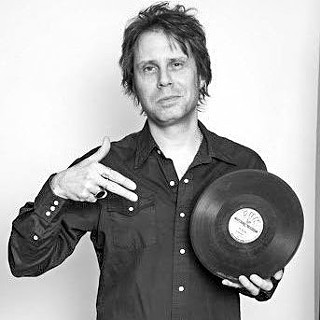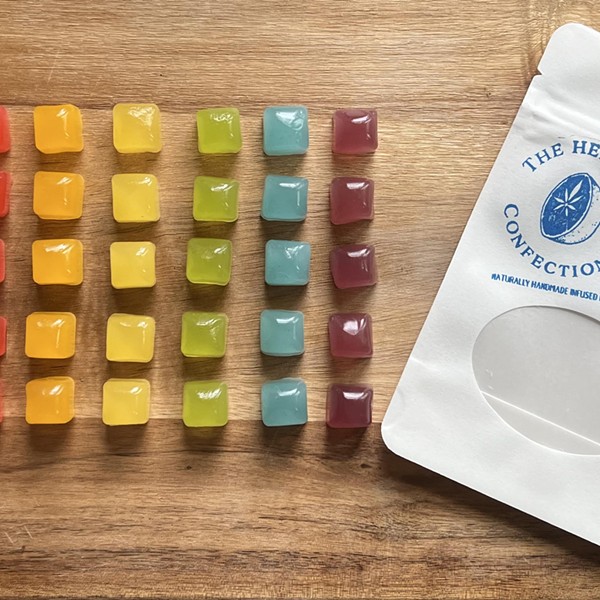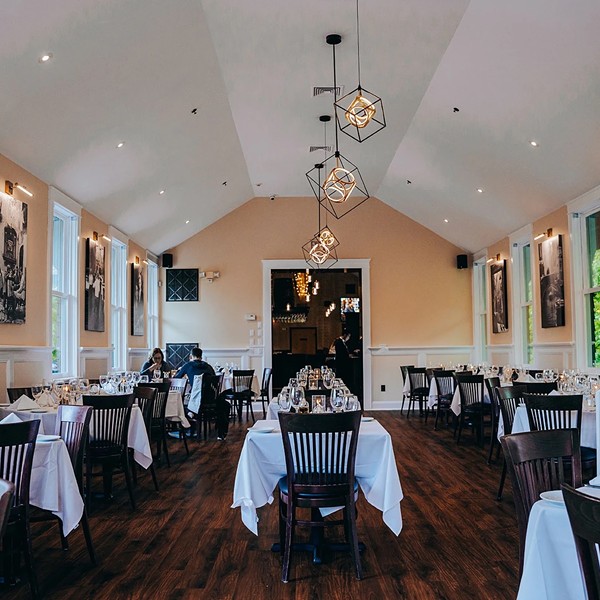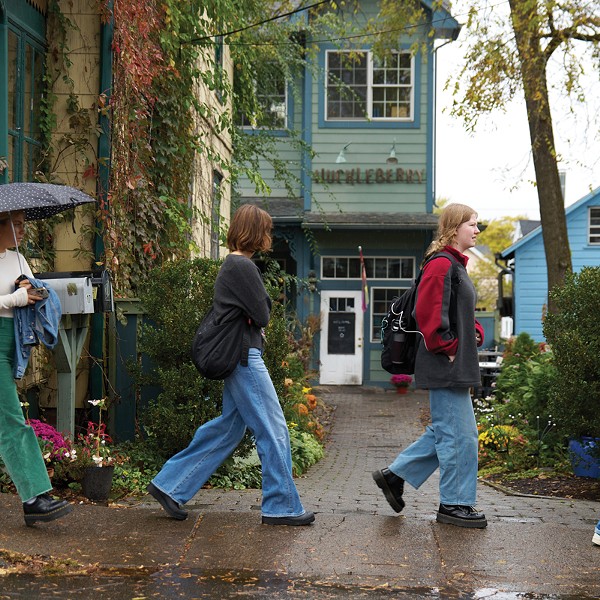
It's a perfect June evening and members of New Paltz band Upstate Rubdown are sitting on plastic chairs outside the house where they rehearse, basking in the afterglow of their appearances at Mountain Jam and Virginia's Herndon Festival days before. "Mountain Jam was great," says Kate Scarlett, one of the group's three singers. She adds, in giddy disbelief, "We saw all of these people we didn't even know wearing [Upstate Rubdown] T-shirts—before we'd even played." With eight busy members, it was, unsurprisingly, difficult to corral the entire band for an interview on one of their precious days off. But we did okay, snagging five. Present in addition to Scarlett are her sisters in harmony, Mary Kenney and Melanie Glenn, upright bassist Harry D'Agostino, and newly added saxophonist Christian Joao (although the latter two will soon be dashing off to rehearse for a side gig). Elsewhere tonight are mandolinist and backup singer Ryan Chappell, percussionist Dean Mahoney, and guitarist Dave Berger, an early member who recently returned to the fold.
Although Joao, from Rosendale, is the only one of the players (ages 21 to 30) who was raised in the region—the others hail from Ithaca, Rochester, Long Island, Manhattan, and Greenwood Lake—as a band, Upstate Rubdown is about as New Paltz as one can get. Made up entirely of SUNY grads, the group grew out of open mikes and spontaneous sings at parties, building their acoustic, post-indie, kitchen-sink folk style on the aesthetic mapped out by local heroes the Felice Brothers. The octet's rehearsal pad is a raised ranch just outside the village, in farm country. And farming, if you will, lies at the root of Upstate Rubdown. "Melanie and I met through [SUNY organization] Students for a Sustainable Agriculture," says Kenney, who mentions that some of the group's music was inspired by old work songs they've learned. "Sometimes when I'm working in the fields and singing, I'll get an idea for a song and I'll stop to record it on my phone so I can come back to it later. The band name came out of us trying to think of something we all had in common, which is where the 'upstate' came from. I was trying to think of another word that fit with that had 'down' in it—I thought that would sound good. Then a roommate yelled out, 'Rubdown!' and we were, like, 'That's it!'"
Along with folk and field hollers, Upstate Rubdown's infectiously sunny organic stew stirs together strands of bluegrass, jazz, blues, Broadway, gospel, soul, and pop. When it comes to the group's instrumental format, two uncommon facets stand out immediately. First are the fleet, irresistibly melodious harmonies of Kenney, Glenn, and Scarlett. Their sleek voices rise together as one and soar and dip like tandem birds, each peeling off to take their own solo turn before intertwining once again. Hearing them perform, it's unfathomable that the three women didn't grow up singing together, like close harmony acts the Andrews Sisters or the Roches, to whom they've been compared (your music editor is reminded of the stacked tones of the Boswell Sisters; Kenney cites contemporary Vermont trio Mountain Man as a key influence). Nor is it conceivable when Kenney says that that neither she nor Scarlett were accepted when they auditioned for the SUNY a cappella choir, before Upstate Rubdown came together. "We love singing a cappella, inside and outside the band," says Glenn, who sang in church choir as a child. "Usually in our shows we'll have these mini-a-cappella sets within the main set. It's always scary at first, to watch the silence come over the room when people are first hearing just the three of us with no instruments."
The second of the group's secret weapons is Mahoney's unique choice of a primary percussion implement: the cajon, a wooden, boxlike instrument from Peru played with the hands. "We tried a [full-kit] drummer at first, but then the idea of the cajon came along," D'Agostino recalls. "We found it worked great because it's a way to add percussion 'surgically' to the songs, without overpowering the vocals or the other instruments." "The instrumentation just evolved really naturally," Kenney elaborates. "Musicians come and go, and then someone else, maybe even someone who plays a different instrument, comes along to take their place. Or else someone who left comes back." (Indeed, Scarlett originally came aboard to temporarily replace Glenn, who'd decided to live out West for a spell, but remained when Glenn returned.)
Such has been Upstate Rubdown's story, that of sprouting new buds to replace the ones that dropped off. Initiating their changeable lineup in 2011, the band woodshedded their sound at house parties and busked around, eventually catching the ear of local resident and tenured music agent Jim Kramer (the Police, Blondie, Hall & Oates), who helped them expand their gigging circle beyond New Paltz and into higher-profile Hudson Valley music venues. One such club was the Falcon in Marlboro, where producer Jason Miles (Sting, Miles Davis, Chaka Khan) happened to be having dinner with his wife one night when the earnest young outfit took the stage. "It was one of those seemingly random moments that turned into a profound life experience," remembers the music industry veteran of 43 years. "I didn't know anything at all about these kids before that, but right away I could tell there was something there. They had these amazing harmonies and this great, totally organic sound. I loved the songs—they had lots of great melodies."
Miles agreed to produce the band's debut, A Remedy (Independent), which was recorded at Woodstock's Dreamland Recording Studio using the $22,000 the group raised through a Kickstarter campaign. For most of the members, it was their first time in a recording studio. "It was a pretty emotional experience for us, being newbies," Kenney recounts. "We had to learn about putting trust in Jason and the other people we were working with. It was kind of a meshing of younger thought with older experience." But whatever educational bumps there may have been during the process, the results were worth it. A Remedy rollicks and romps with buoyant and bewitching tracks like "No Slack" and "Bad Enough" and the sweetly lonesome "Nobody," which features the sublime soloing of a special guest: legendary saxophonist Joe Lovano, who appeared at the behest of Miles, his neighbor. "Harry had met him and knew his music, but I didn't really know about him before we made the record," says Kenney. "But a few weeks after we were done recording I was driving through Massachusetts and had some random jazz station on and they were playing his music and talking about him. So then it hit me and I was, like, 'Oh, wow.'"
Released in July 2015, A Remedy has been well received, getting a favorable plug via NPR for its "joyful, light-footed noise" ("It's kind of a dream of ours to do a Tiny Desk Concert," confesses Scarlett). And soon the Rubdown hits the road, when the group embarks on a six-week tour to promote the record later this year. Not that they're staying idle during the lead-up: In addition to doing weekend jaunts for summer festivals and isolated club dates, the group recently cut a downloadble tour EP and has 12 songs in development for their second album, while Kenney, Glenn, and Scarlett have an a cappella album, tentatively titled Triumvirate, in the can. And to put a (foamy) head on things, New Paltz nightery Bacchus has even brewed up a craft beer named for the band. The limited-edition beverage will be on tap when the group plays the popular bar/restaurant this month, the proceeds from its sales going help fund their upcoming tour. "The material we play connects us to our fans, and it also makes us feel a sense of connection to the music of the past," says D'Agostino. "So it's the music itself that's kept us going."
Upstate Rubdown will perform at Bacchus in New Paltz on July 7.

















